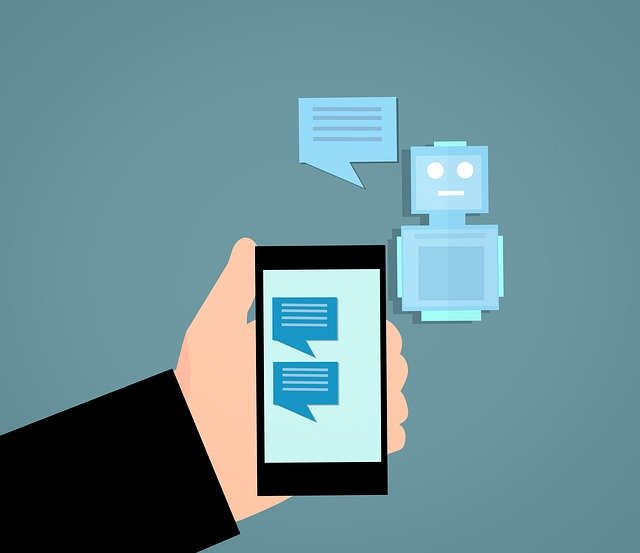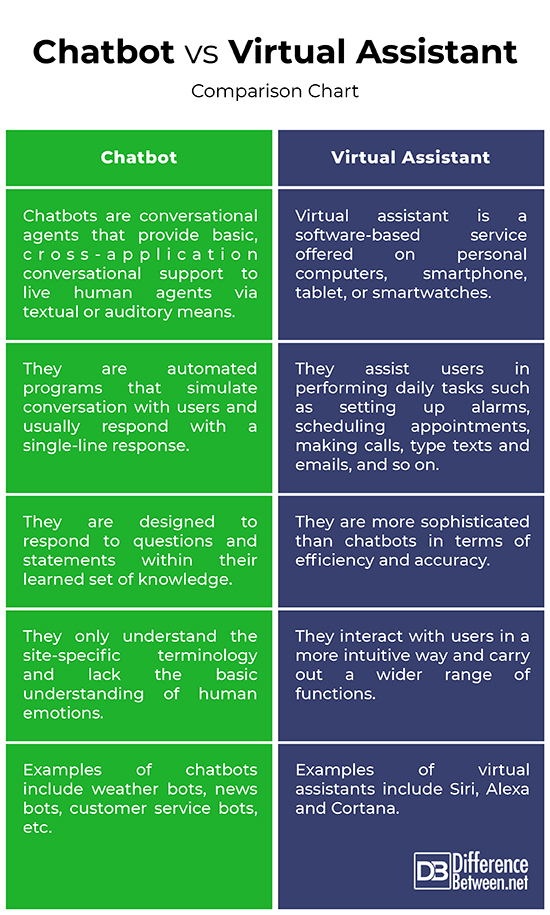Difference Between Chatbot and Virtual Assistant
As artificial intelligence evolves at an astounding pace, organizations around the world are trying hard to identify potential areas to get the most of AI. Organizations are now actively leveraging conversational interfaces, such as chatbots and virtual assistants, to help augment business productivity and innovate their operations by automating their business processes. This new user interface is revolutionizing the way humans interact with software. Thanks to chatbots and virtual assistants, software is now able to meet humans and interact with them in an intuitive way.

What is a Chatbot?
Chatbots are just another kind of software generally used as information acquisition interfaces. Chatbots are conversational agents powered by artificial intelligence that can interact with users in a conversational manner using natural language processing. They are automated programs that simulate conversation with users and usually respond with a single-line response. Chatbots are virtual advisors, assistants or agents that let users interact with services and brands using their favorite messaging apps. Chatbots are generally used by organization for product marketing, brand engagement, product assistance, sales, and support conversations. They play a fundamental role in customer service, wherein they are used as a medium to facilitate interaction between a human and a machine via text or text-to-speech. Chatbots can assume the function of a live human agent and provide the users with required assistant in finding information regarding products or services.

What is a Virtual Assistant?
A virtual assistant is a digital software-based personal assistant that use the most advanced means of communication to assist the users in performing daily tasks such as setting up alarms, scheduling appointments, making calls, type texts and emails, and so on. In general, virtual assistants are independent contractors that provide professional administrative, technical, or personal support services to clients remotely from home, irrespective of geographical locations. They are just like their human counterparts that help with, let’s say, bookkeeping, document preparation, travel planning, or reading messages and emails. Similarly, virtual assistants provide personal assistance through helping you work across devices, managing smart devices, keeping up with latest news, getting directions, answering queries, setting alarms, scheduling appointments, and more. Virtual assistant is basically a software-based service offered on a general-purpose computing device such as a personal computer, smartphone, tablet, or smartwatch, which is designed to help users complete tasks using voice and natural language processing (NLP).
Difference between Chatbot and Virtual Assistant
Basics
– Chatbots are generic, stand-alone conversational agents that provide basic, cross-application conversational support to live human agents via textual or auditory means. Chatbots are virtual advisors, assistants or agents that let users interact with services and brands using their favorite messaging apps. Chatbots are also referred to as conversational agents, conversational interfaces, virtual advisors, assistants or agents.
Virtual assistant, on the other hand, is a software-based personal assistant that uses the most advanced means of communication to perform tasks such as managing a calendar, setting alarms, sending texts, making calls, and playing music.
Functions
– Chatbots assume the function of a live human agent and provide assistance with finding information regarding products or services, updating customer details, gathering information, providing delivery information, or any information in the customer service space. Chatbots function with a specific set of guidelines in its conversation. It is simply a robot assistant that responds to your basic queries.
Virtual assistants, on the other hand, are more advanced and interactive than chatbots, wherein they interact with users in a more intuitive way and carry out a wider range of functions, such as set alarms, schedule appointments, make calls, type texts and emails, answer queries, and so on.
Accuracy
– While both chatbots and virtual assistants are an integral part of our daily lives that help us in many ways, chatbots lack the basic understanding of human emotions. Chatbots only understand the site-specific terminology and are designed to respond to questions and statements within their learned set of knowledge.
Virtual assistants, on the other hand, use powerful natural language processing to interact with us in more human-like fashion, offering higher efficiency and accuracy with a little or no margin for errors. Virtual assistant is much more sophisticated than chatbots.
Examples
– Chatbots are conversational agents that are modeled after customer service executives and store assistants. Chatbots are mostly deployed on messaging apps such as Facebook Messenger, Slack, Skype, and other enterprise assistants. The most common examples of chatbots include weather bots that forecast about your local weather, news bots that update latest or breaking news, or customer service bots.
On the other hand, virtual assistants are more advanced bots like Apple’s Siri, Amazon’s Alexa, and Microsoft’s Cortana, which act as your personal digital assistants and can be extended in terms of their capabilities.
Chatbot vs. Virtual Assistant: Comparison Chart

Summary of Chatbot vs. Virtual Assistant
Chatbots have been very successful in the finance industry, banking, and legal and health sectors. They are becoming coworkers by assisting fellow workers with mundane and boring tasks. Messaging services such as Facebook Messenger, Slack and Skype have been encouraging chatbots on their platforms to automate in-house communication. However, chatbots are still behind virtual assistants when it comes to context, intellect and intelligence. Virtual assistants like Siri and Alexa are an advanced form of chatbots that are able to carry out a wider range of functions with much accuracy and efficiency.
- Difference Between Caucus and Primary - June 18, 2024
- Difference Between PPO and POS - May 30, 2024
- Difference Between RFID and NFC - May 28, 2024
Search DifferenceBetween.net :
Leave a Response
References :
[0]Shevat, Amir. Designing Bots: Creating Conversational Experiences. Sebastopol, California: O'Reilly Media, 2017. Print
[1]Janarthanam, Srini. Hands-On Chatbots and Conversational UI Development. Birmingham, United Kingdom: Packt Publishing, 2017. Print
[2]McTear, Micheal, et al. The Conversational Interface: Talking to Smart Devices. Berlin, Germany: Springer, 2016. Print
[3]Image credit: https://pixabay.com/de/illustrations/chatbot-chat-anwendung-k%C3%BCnstliche-3589528/
[4]Image credit: https://commons.wikimedia.org/wiki/File:Cartoon_Female_Virtual_Assistant_Earning_Money.svg
